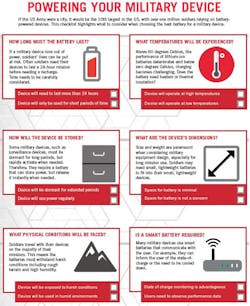The power requirements of military equipment differ from those of many other devices. Military personnel don’t have the luxury of having field-service representatives on every deployment. Having intuitive, compact, and reliable devices can therefore be critical to the success of a military operation. To guide design engineers when choosing a battery for their military device, global military battery specialist Ultralife Corp. published a checklist highlighting the important considerations.
The global demand for connected devices is growing, with trends such as the Internet of Things (IoT) and home automation setting certain expectations from users. This is driven by developments in communications protocols and sensor technology, which has made it easier to integrate network connectivity and remote-control systems into an increasingly wide variety of devices.
As such, these technologies are becoming increasingly common in a wide range of sectors, even penetrating military and defense. For the military, interconnected and portable devices are most desirable for soldiers on covert operations, but there’s been a growing trend of wearable technologies for wider military use.
To deal with this growth, the checklist, which can be downloaded from Ultralife’s website, consists of five key questions that design engineers must ask themselves before choosing a battery for a military device. The answer to each question will depend on the design of the device, how it will be used, and in what conditions.
“Unlike most battery-powered equipment, military devices are often exposed to incredibly harsh conditions such as extreme temperatures, rough physical handling, and high moisture environments,” explains Johnathan Celso, applications engineer at Ultralife.
“Design engineers must choose batteries capable of withstanding these conditions,” says Celso. “To increase a battery’s robustness, they may also need to incorporate protective structures into the design.
“However, robustness isn’t the only essential consideration. The battery must power the device in accordance with the needs of the soldier. For example, some devices are required to lie dormant for long periods, but rapidly activate when needed.”
The failure of a device to meet a soldier's requirements impedes the soldier's ability to do their job and puts their lives at risk. The earlier that design engineers consider the battery, the better the device they provide to soldiers to meet their needs.
As technology advances, the opportunities to provide soldiers with high quality, beneficial equipment are increasing. For example, many military devices now use smart batteries that communicate with the user regarding information such as the state-of-charge or the need to be cooled down. This checklist should prompt design engineers to make the high-level considerations before embarking on new projects.
Major Move to Wearables
Overall, it’s predicted that 350 million wearable devices will be in use worldwide by 2018, so it’s no surprise that these technologies would also be put to use in military applications. Wearable technologies will enable soldiers to be tracked with greater accuracy, making it easier in high-alert operations to monitor the safety of soldiers and reduce the risk of errors.
Wearables can also be designed to go unnoticed and blend in with a soldier’s kit. Typically, a soldier can be carrying equipment weighing anywhere between 40 and 80 kg on deployment. Designing devices that are compact or can be integrated into a soldier’s armor isn’t only desirable, but will also improve the soldiers speed, providing that it’s also lightweight.
In addition, original equipment manufacturers (OEMs) in the defense sector are also providing soldiers with tactical advantages by replacing radio handsets with hands-free communication devices. This is one example where the reliability and resiliency of a device is imperative. If a soldier needs to call for backup, having a radio with no battery could become a life-threatening situation.
A lack of reliable battery power puts many soldiers in a compromising position when in the field. This is because there is often a 72-hour deployment window and batteries for these missions must be prepared and able to last extended periods of time without charging.
The increased efficiency promised by IoT technologies, as well as the decreasing cost of suitable components, is the biggest driver for next-generation military devices and applications like wearable technologies. OEMs must carefully consider the design of their next interconnected device to ensure it’s combat-ready, especially as failure to deliver reliable equipment could risk a soldier’s life.
Michele Windsor is Global Marketing Manager at Ultralife Corp.


